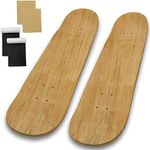Buying Guide for the Best Skateboard Decks
Choosing the right skateboard deck is crucial for your overall skateboarding experience. The deck is the flat board that you stand on, and it comes in various shapes, sizes, and materials. Your choice should be based on your skating style, skill level, and personal preferences. Here are some key specifications to consider when picking the perfect skateboard deck for you.WidthThe width of a skateboard deck is measured in inches and typically ranges from 7.5 to 8.5 inches. This spec is important because it affects your balance and control. Narrow decks (7.5-7.9 inches) are lighter and easier to flip, making them ideal for technical street skating. Medium decks (8.0-8.25 inches) offer a balance between flip tricks and stability, suitable for all-around skating. Wider decks (8.25 inches and above) provide more stability and are better for vert, pool, and cruising. Choose a width that matches your skating style and foot size.
LengthThe length of a skateboard deck is measured from the tip of the nose to the tip of the tail and usually ranges from 28 to 33 inches. This spec is important because it influences the deck's overall feel and maneuverability. Shorter decks (28-31 inches) are more agile and easier to control, making them great for street skating and technical tricks. Longer decks (32 inches and above) offer more stability and are better for cruising and vert skating. Consider your height and skating style when choosing the length of your deck.
WheelbaseThe wheelbase is the distance between the inner mounting holes of the deck and typically ranges from 13 to 15 inches. This spec is important because it affects the turning radius and stability of the skateboard. Shorter wheelbases (13-14 inches) provide a tighter turning radius, making the board more responsive and easier to maneuver. Longer wheelbases (14.5 inches and above) offer more stability and are better for high-speed skating and larger ramps. Choose a wheelbase that complements your skating style and the type of terrain you skate on.
ConcaveThe concave of a skateboard deck refers to the curvature across the width of the board. This spec is important because it affects the grip and control of the deck. Low concave decks have a subtle curve and are more comfortable for cruising and beginners. Medium concave decks offer a balance of grip and control, suitable for all-around skating. High concave decks have a steep curve, providing maximum grip and control for technical tricks and aggressive skating. Choose a concave that matches your skill level and skating style.
MaterialSkateboard decks are typically made from layers of maple wood, but other materials like bamboo, fiberglass, and carbon fiber are also used. This spec is important because it affects the durability and weight of the deck. Maple wood decks are the most common and offer a good balance of strength and flexibility. Bamboo decks are lighter and more eco-friendly but may not be as durable. Fiberglass and carbon fiber decks are very strong and lightweight but can be more expensive. Choose a material that fits your budget and durability needs.
ShapeThe shape of a skateboard deck includes the nose, tail, and overall outline of the board. This spec is important because it influences the board's performance and suitability for different types of skating. Standard popsicle shapes are symmetrical and versatile, making them ideal for street and park skating. Old school shapes have a wider nose and tail, providing more stability for cruising and vert skating. Choose a shape that matches your skating style and the tricks you want to perform.

![[CCS] Logo Skateboard Deck Pink 7.7](https://images-proxy.bestreviews.guide/dOrVqwZuh8fKX1wa6R5kmxwEJHs=/0x150/https://m.media-amazon.com/images/I/21neIqUe6tL._AC_CX679_.jpg)

















